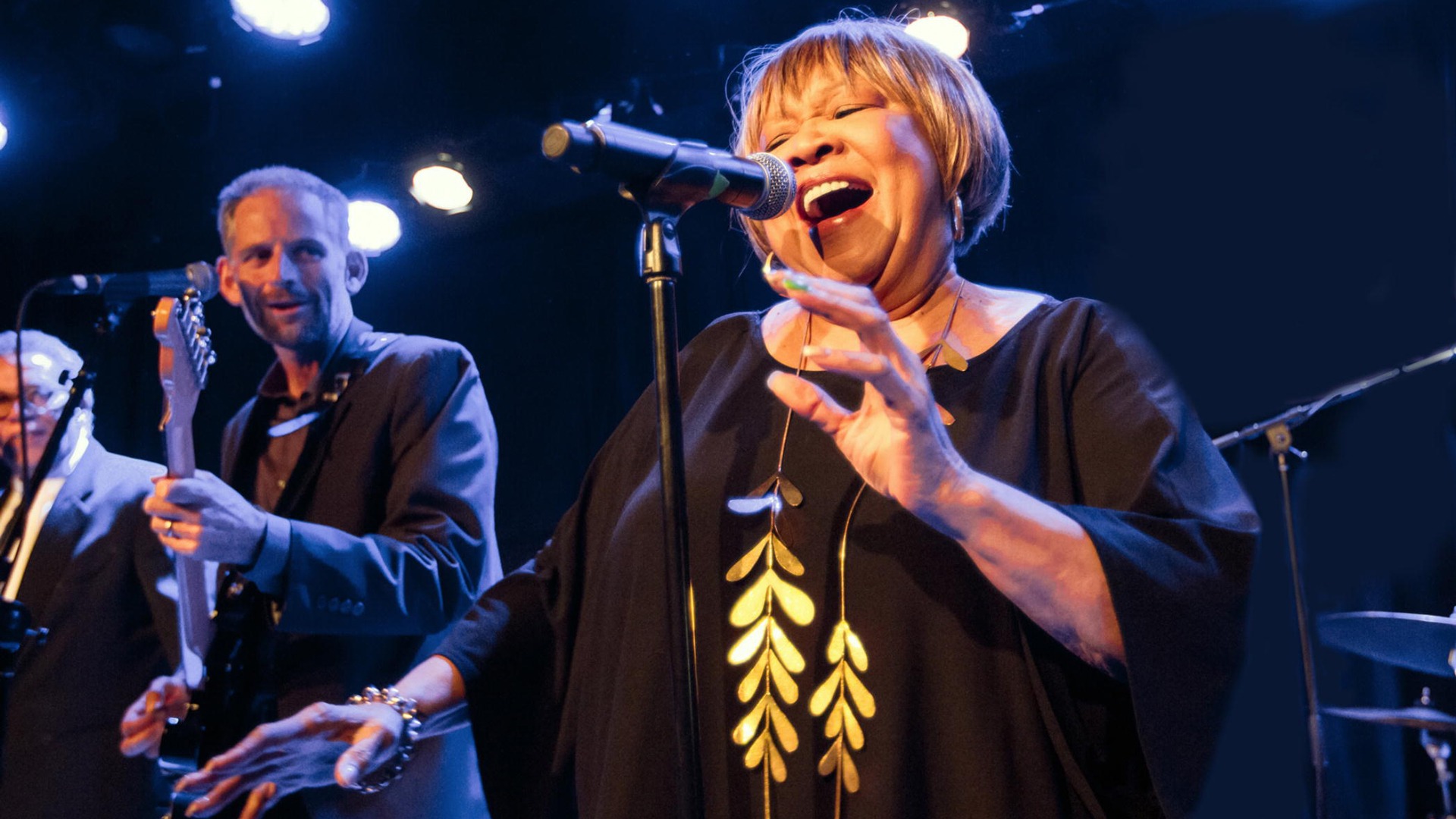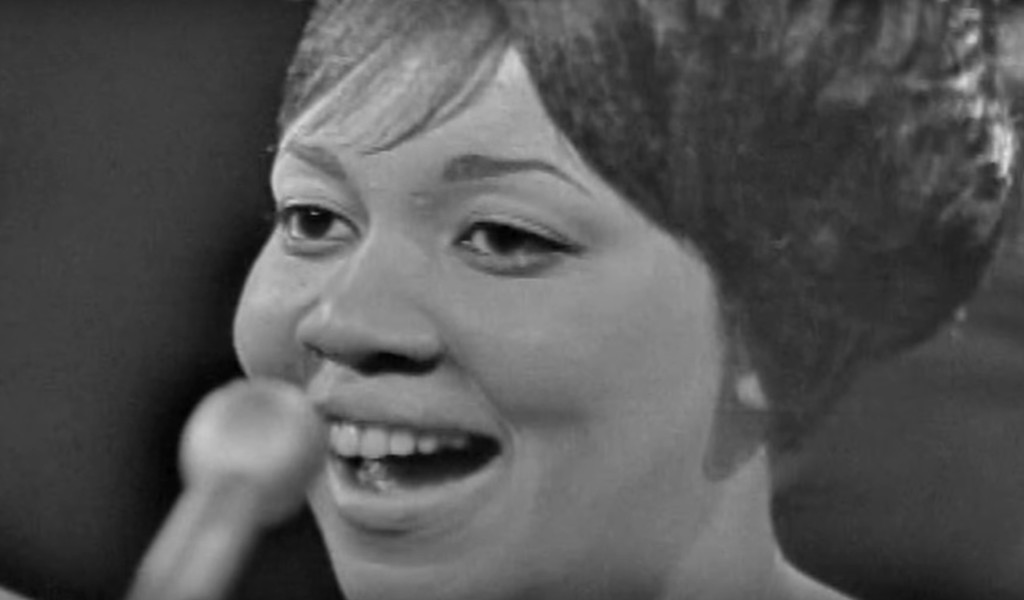
Written by Ren Jender.
At one point during Mavis!, the new documentary about legendary soul singer Mavis Staples that is airing on HBO this month, we see an old clip of Staples’ father, Roebuck “Pops” Staples who founded The Staples Singers, the family group that brought fame to all of them. A host of a TV music show asks the tired question: how does he feel about performing secular music after years of performing at churches as a gospel group? With no malice or a second’s hesitation Pops answers that he thinks of the “freedom songs” they sing as exactly the same as gospel: simply “the truth.”
Watching Mavis Staples in the film, still touring at 75, after more than 60 years on the road (she remarks about one of their early records that no one could believe a petite 13-year-old girl was the lead singer: they thought her strong, low voice was a man’s) we can’t help noticing she seems to have inherited both Pops’ good nature (though band members tell us she lets them know when she finds their performances lacking) and his certainty. Her band, now made up of white musicians decades younger than she is, her older sister, Yvonne, and a woman in her late thirties/early forties with a nose ring in a T-shirt that reads “Black Weirdo,” still performs an a cappella gospel song to warm up before going onstage.
Director Jessica Edwards includes plenty of the Staples’ less familiar music — which still sounds fresh and striking: I predict most people who see this documentary will quickly add the Staples Singers to their music selections — as well as photos and TV clips from their appearances stretching back to the 1950s. Pops had a smooth, clear voice, but Mavis usually had the lead vocal even at the beginning. Like Amy Winehouse, her style and virtuosity were already an adult’s when she was a young teen.
Although the Staples family was based in Chicago, Pops had been part of the Great Migration from the South. He grew up in the same part of Mississippi as some of the great blues legends who influenced his own style of guitar playing, making it distinct from other gospel musicians. In the 1950s and 1960s, rock and roll radio stations played gospel music after midnight, which Bob Dylan explains, is how he discovered the Staples Singers, as did other white musicians of the era. Some of the songs we hear with Pops on lead have more than a passing resemblance to more familiar radio hits from white rock and roll bands in the 1960s. Levon Helm, of The Band, tells us their own harmonies were directly influenced by The Staples Singers.
When the Staples and Dylan appeared on the same stages (including on an early TV musical omnibus) Mavis and Dylan had a puppy-love romance — and Pops expanded their repertoire. After first hearing “Blowin’ in the Wind” he told Mavis and the rest of the family, “We can sing that song.” He was particularly struck by the lyric, “How many roads must a man walk down/ Before you can call him a man?” When Pops, a man who had fled the Jim Crow South when Black men were still called “boy” sang those words, they were especially poignant.
Pops also attached the group early on with the Civil Rights Movement, becoming an acolyte of Martin Luther King in 1955, at a time when one of the white experts interviewed tells us, “Very few gospel singers took an interest in Civil Rights.” Pops began to write songs inspired by the movement including “Why Am I Treated So Bad?” one of Dr. King’s favorites.
Like a lot of other performers with a similar background, Mavis traded an audience that was once nearly entirely Black (as in a terrific clip we see of the Staples Singers live performance in Watts Stax, a filmed all-star concert and fundraiser for the pre-gentrified Oakland of the early 1970s) to one that is now, we see at appearances like the Newport Folk Festival, nearly entirely white. Mavis still mentions Dr. King to them and seems to see her continued performing as a way of elevating those who hear her music. She tells them and us, “I’ve weathered the storms. I’ve fallen down and I’ve gotten back up.”
[youtube_sc url=”https://www.youtube.com/watch?v=-orbaWz5yRQ” iv_load_policy=”3″]
When Mavis! was shown as part of the Athena Film Festival, the director of the film, Jessica Edwards, fielded questions from the audience. The following is a transcript of that Q and A, edited for concision and clarity.
What was it about this story that made you want to make this film?
Jessica Edwards: It was really Mavis that made me want to see this movie and therefore make this movie. I had seen her perform in Brooklyn, in Prospect Park a couple of years ago and I had known a little about this soul-era Stax stuff, but I went to the show that night and I left feeling rejuvenated. When I went home to watch the documentary, so I could learn more about her, there wasn’t one.
Can you tell us more about what you learned about her as you were making the movie?
JE: The incredible thing that I found about her was that her and her family really touched on almost every genre in the history of American music: anything that influenced the way that music is made now. She influenced all these makers that then became paramount in terms of what American music became, like Bob Dylan. And Dylan himself has influenced so many people. You think about him listening to the family late at night and then what he became, the idea that she was so part of this fabric of music in this country.
One of the things that impressed me is that you portrayed her and her music and kind of the intersection of music, culture and politics. Was that a conscious decision on your part or was it just an outgrowth of who Mavis was?
JE: You know the Civil Rights Movement didn’t end for Mavis in 1968. For her, the Civil Rights Movement is now. For me music is culture. I’m not a very religious person, but music is a spiritual experience for me and always has been. The idea that music can facilitate change in a way that some other things can’t, that was really solidified for me. The message of Dr. King was not completely mainstream in the mid-fifties and Mavis and her family were instrumental in terms of this grass-roots movement of going from church to church to church in the South and bringing these messages of equality.
How much was Mavis involved the making of this film?
JE: Mavis didn’t see the film until it was finished. In fact, it took her a while to get on board. She was like, “I’ve been talking to the press forever. I don’t need to do this. Like, nobody wants to hear about me.” But when we started to talk to her about the kind of film we wanted to make and how it really was not only her legacy, but the legacy of her family and the legacy of their music, she came around. She trusted us. I offered to come to Chicago and screen it for her before it was screened publicly. And she said, “Nah, I’m gonna watch it with the people.” Then she sat in the theater with a thousand people and watched it for the first time. That was a little nerve-wracking for some of us. But she loved it. The first time she watched it, she doesn’t really remember what it was. All these memories just kept flooding back. I sat directly behind her, and the first time Bob Dylan comes on the screen and he says all these wonderful things about the family, she just started giggling like she was 15 years old. She watched it more recently. We screened it in Chicago a week or so ago and she came up to me after and she was like, “I finally saw the movie, this time. It was really good!”
I have a question about process from the inspiration to okay, now how do I get this to really happen?
JE: This movie took about two and a half years to make which in documentary-land is incredibly fast. It’s like a snap of the fingers. And basically, once she agreed I went and visited her and we would drop in on her on the road. We would film the show. We would spend some time backstage. And then we would go back to Chicago when she was home. The way I structured the shooting was, we did it for her 75th year. Otherwise I would still be shooting. The woman is touring all the time and I’d never end the movie. The movie is also self-financed. Luckily, we have HBO as a broadcast partner. They’re like a fairy godmother of documentary films.
I almost like cried at the moment where Mavis is listening to the song Pops played and she’s getting choked up. How are you able to get such intimate, candid moments without feeling like you’re getting in the way?
JE: I think people who’ve made a hundred films will have the same question. This is my first feature length film and I always feel nervous in those situations, but my DP, he was, like, ruthless, so, as nervous as I was, he’d be like, “Just keep filming.” I hired people who have done this way more than I have, so I could learn so much. So the next time I do this, I won’t ever cut either. Whether you’re filming something that’s too intimate or not, ultimately you can make the decision of whether you’re going to use it later. It’s much better to have it, because you don’t know whether you’re going to need it. In that particular scene, I was sitting underneath the soundboard. I wanted them to talk to each other, not talk to me. I knew that I’d have to ask them questions at the same time to get them talking. I was crying my eyes out, bawling under the sound board like a baby. And as soon as we got that scene, I knew that we had a movie.
I just wondered if you could speak to the finances of the movie, how did it work out for you? And what’s next for you?
JE: I have a production company and the executive producer of this film is my partner, like my baby-daddy partner. We work together on a lot of stuff, so he raised a lot of money through commercial work basically while I was shooting. So he would work on commercial jobs which would pay for this film. It opens the question of sustainability especially if you live someplace expensive like Brooklyn. But I knew, if we felt this passionate about Mavis and because she has so many fans, people would want to see the movie. We’ve had such a wonderful response. I feel like we made the right decision to be late on our rent a couple of months. Now I’m doing a lot of work with 360 Video. I really am enjoying the challenge of making something really short and non-linear. There are a couple of documentaries in the pipe, but for every one you make you have to pitch ten, so I think I’m, like, at six. It’ll hit any minute.
Ren Jender is a queer writer-performer/producer putting a film together. Her writing, besides appearing every week on Bitch Flicks, has also been published inThe Toast, RH Reality Check, xoJane and the Feminist Wire. You can follow her on Twitter @renjender.

